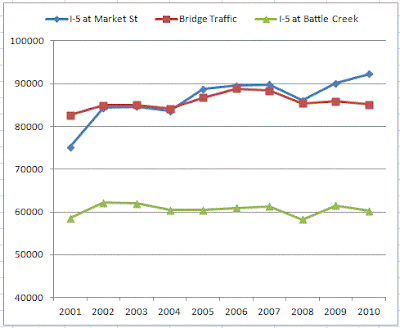Unsurprisingly the Oversight Team has taken for its motto, "Go Big or Go Home." The hypertrophied alternative they are leaning towards is 4D. Interestingly enough, the April OPB guide had a picture of its twin, so it is not so difficult to visualize:
 |
| The April OPB Cover Shows the Cross-Section! |
Other items include some right-of-way acquisition for sidewalks near schools on Ellis NE and Gerth NW.
More funding for the Glen Creek Trail connecting the Union Street RR Bridge to Glen Creek Road.
And some interesting real estate orts along Pringle Creek and the path, which the City proposes to transfer from Urban Development to the City proper - I suppose occasioned by the fact that the Pringle Creek URA is going to disappear.
But even without a hearing, the big item is the bridge of course.
Both the OPB picture and option 4D are six lane cross-sections, with very similar ramp systems!
 |
| A Superhighway Bridge, Just like the OPB Picture |
 |
| 4D Overview in Blue and Widening in Grey |
 |
| The Ramp System Tears Up Highland and Creates Barriers |
 |
| Front Street NE Viaduct and Desolation |
 |
| Westside Impacts on Wallace Park, Wallace Road, Glen Creek, and Edgewater |
 |
| Big New Road System at West Bridgehead |
 |
| Viaduct and Ramp Looms Over Wallace Park |
 |
| Further Separates Edgewater from River |
 |
| Ramp and Viaducts Create Huge, Looming Barrier |
Here's an elevation view of the viaducts in Wallace Marine Park at Glen Creek and the Courthouse Fitness building. The ramps also take out all of the greenway on the south edge of Edgewater.
 |
| Elevation View of the Viaducts and Ramps |
The current cost estimate for this bridge and highway is $687 million, and with likely cost overruns will approach or even exceed $1 billion. While ODOT trumpets its ability to bring projects in at budget, this holds true for only small and medium size projects; nearly every recent project of the magnitude of the proposed bridge and highway in Oregon has had significant overruns (see the Cortright report for Plaid Pantry), especially the debacle on Highway 20 near Eddyville as well as the Newberg-Dundee by-pass.
So while the hearing won't be until after the election, by creating noise now, you can help prepare the way for a rational decision. Email Citycouncil@cityofsalem.net and urge Council to tell the Oversight Team to "go home" and quit wasting money (over $6 million so far) on fantasies!
 |
| Staff Report to Council Minimizes Dissent |
Update, mid-day Sunday
Commenters rightly ask for data! Here's a graph with traffic on the bridges, and two locations on I-5, the Market Street interchange and the Battle Creek - Sunnyview interchange on the southern edge of town.
Only the Market Street shows an increase. (Source: ODOT Traffic Counts and discussion here.)
 |
| Contrary to Modeling, Bridge Traffic (Red) is Declining |



4 comments:
You know, I failed to point out that the Glen Creek path has already had some $100K in overrun.
So if a dinky 850 foot path has an overrun (and there might be more, as construction hasn't even started yet!) of 50% or so, what makes us think the considerably more complicated job of several miles of bridge and highway will come in at or under budget?
There is no reason to trust the cost numbers we are being given.
Great post SBOB. You laid it all out. What an amazingly bad idea this is. A fantasy indeed. The only thing you failed to mention is that traffic on the existing bridges is DOWN, not up since 2006 (a little over 4%). So this is a $687 million solution to a a problem that doesn't exist.
Sightline Daily has some of the best reporting on how flawed forecasting as lead to revenue shortfalls for a number of Northwest highway and bridge projects. Plus a nifty little report projecting VMT to fall 6.5% in our region by 2030. Its not because of shifting modes either, only demographics. The boomers are past their peak driving years and cycling out of the driving pool and there are not nearly enough gen. Xers to replace them.
http://daily.sightline.org/2012/08/15/older-boomers-less-driving/
Thanks! Updated with data. I think I've seen 2011 numbers floating around somewhere, but the ODOT site didn't have them. I'll update the graphs when I see the data, as I believe it shows continued decline as both of you suggest!
Post a Comment